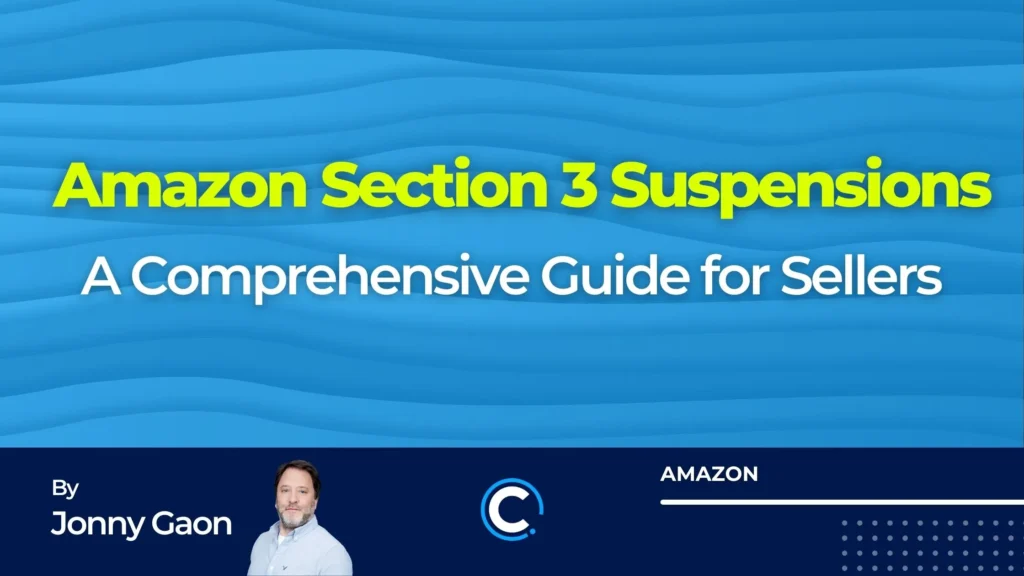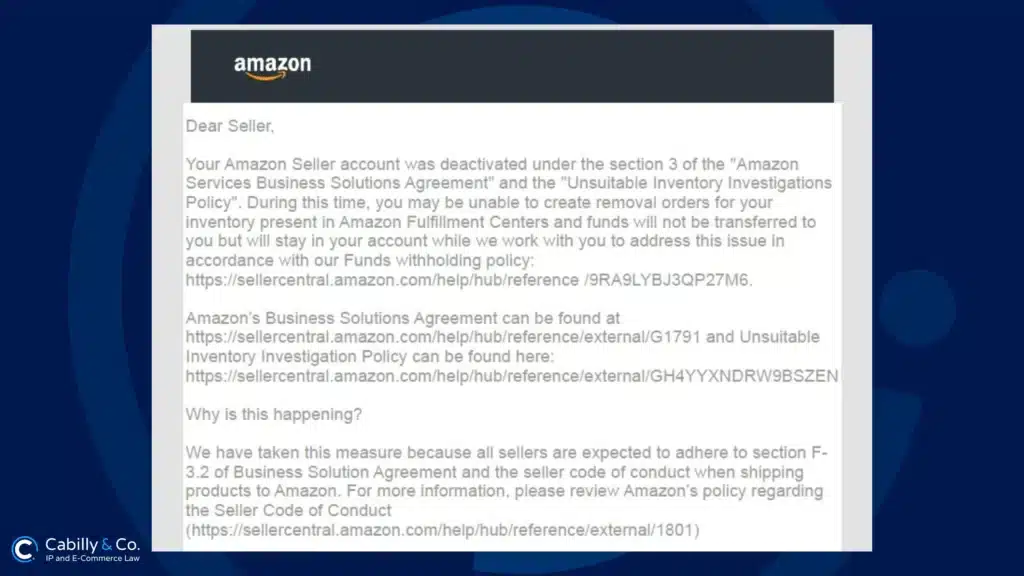
Book a FREE 15-minute consultation with an expert – Book Now
Sellers’ Guide to Amazon Section 3 Suspensions

Entering the world of Amazon selling can be overwhelming. With numerous policies and guidelines, it’s easy to feel inundated. One crucial part of Amazon’s guidelines that every new seller must understand is Section 3. As an Amazon seller, you’ve likely encountered the term “Section 3 suspension.”
Whether you’re new to the platform or a seasoned seller, navigating Amazon’s policies can be daunting. In this article, we’ll simplify Section 3, making it easy to understand while emphasizing its significance for your Amazon selling journey. This guide will explain what a Section 3 suspension is, how to reinstate your account, what your Plan of Action (POA) should include, and tips to avoid these suspensions. Let’s dive in.
What is a Section 3 Suspension?
Section 3 of Amazon’s Business Solutions Agreement is essential for sellers, as it outlines the terms and conditions that govern their relationship with Amazon. It specifies how and why Amazon may terminate or suspend a seller’s account, acting as the rulebook for listing and selling products on Amazon’s marketplace. Understanding this section helps sellers comply with Amazon’s standards, avoiding potential pitfalls that could harm their business.
A Section 3 suspension refers to the suspension of a seller’s account due to violations of Amazon’s seller policies. If Amazon believes a seller’s actions might harm customers or the platform’s integrity, a Section 3 suspension may be enforced.
When an account is suspended, the seller loses the ability to sell on Amazon, which can be a significant setback, especially if Amazon is their primary sales channel. Understanding the reasons behind suspensions can help sellers navigate the reinstatement process more effectively.

Examples of Section 3 Suspensions
Amazon increasingly uses “Section 3” as a catch-all justification for almost all account-level enforcement, whether that be account suspension, withholding disbursements, or other actions. Amazon’s performance notification will generally start with the blanket statement, “Your Amazon Seller account was deactivated under Section 3 of the Amazon Services Business Solutions Agreement,” and may also cite policies that inform their decision, such as the “Unsuitable Inventory Investigations Policy.” Additional vague claims of violations may be included, such as the “Seller Code of Conduct,” “Section F.3.2,” or claims that your account “has been used to engage in deceptive, fraudulent, or illegal activity that harms our customers, other selling partners, and our store.”
Such citations are extremely general and do not usually provide any real insight into the reason for Amazon’s actions. However, the notification may provide hints as to the actual issue and, sometimes, if you are lucky, the ASINs in question. While the specific cause of enforcement may be evident to the account holder, it is not always the case. As Account Health is often unable or unwilling to provide this information, significant research and guesswork may be required. Section 3 deactivations can result from a huge range of violations; however, some common reasons for them are:
Unaddressed or Failed Supplier Verification and Authenticity Reviews
These can include ASINs flagged for authenticity complaints on the dashboard, FBA Inventory Reviews, shipping inventory without Transparency codes, etc… If Amazon asks you to demonstrate the authenticity of your products and is not satisfied with the documentation provided, a Section 3 deactivation is a likely outcome.
Listing Restricted Products
This can include listing products that require FDA regulation (such as 510k), products identified as drug or medical products, or products that are inherently restricted, such as drug paraphernalia, offensive content, or weapons.
Unresolved Received IP Complaints
An accumulation of unresolved IP complaints can also lead to Section 3 deactivations.
Product Review Manipulation
Amazon are increasingly clamping down on all forms of review manipulation, whether the use of infringing inserts, improper buyer-seller communications, or other methods. Repeat infringements will very likely be met with a Section 3 deactivation.
Failed Account or Identity Verification
All sellers must verify their identity and business information when they first open their account and usually each year. If verification documents and information are not accepted after a number of submissions, Amazon will suspend the account and send a Section 3 notice.
Related Accounts
Whether this is a genuine case of Amazon connecting your account to a separate account, or one of your sub-markets is deactivated for any reason, causing your other markets to be suspended, Amazon will consider this a Section 3 violation.
Overall, almost all issues that lead to account deactivations fall under Section 3, as this is the section of the agreement that deals with how and why Amazon may terminate or suspend a seller’s account.
Reinstating Your Amazon Seller Account After a Section 3 Suspension
When your Amazon seller account is suspended, it can be a significant setback, particularly if Amazon is your primary sales channel. To reinstate your account, the first crucial step is understanding the reason for the suspension. Carefully review the suspension notice sent by Amazon to grasp the specific issues that led to this action.
Next, you need to create a comprehensive Plan of Action (POA). Your POA should be well-structured and address the core issues identified in the suspension notice. Start by clearly identifying the problems that caused the suspension. Conduct a thorough root cause analysis to explain the underlying reasons for these issues. Your POA should then outline the corrective actions you have taken to resolve the problems and the preventive measures you have implemented to avoid recurrence.
Gather all relevant supporting documents, such as invoices, purchase orders, and screenshots of product listings. These documents will substantiate your claims and demonstrate your commitment to compliance. Once your POA and supporting documents are ready, log in to your Seller Central account and navigate to the Performance Notifications section. Find the suspension notice and click on the “Appeal” button to submit your POA and documents through the appeal form.
Ensure that your appeal is clear, concise, and professional. Avoid using emotional language and focus on presenting facts and solutions. After submitting your appeal, monitor your email and Seller Central account for responses from Amazon. Be prepared to provide additional information or clarification if requested. If your appeal is denied or you need further assistance, consider consulting with professionals or services that specialize in Amazon account reinstatement.
What Your Plan of Action (POA) Should Include
Creating a comprehensive Plan of Action (POA) is essential for successfully reinstating your Amazon seller account after a suspension. A well-crafted POA demonstrates your commitment to compliance and outlines the steps you have taken to address and prevent the issues that led to your suspension. Below are the critical components that your POA should include to effectively communicate your efforts and resolve the situation:
- Identify the Issues: Clearly state the problems that led to the suspension.
- Root Cause Analysis: Conduct a thorough analysis to determine the fundamental reasons behind the issues.
- Detail Corrective Actions: Describe the steps you have taken to address and resolve the problems.
Demonstrate your commitment to resolving the issues and preventing recurrence. - Outline Preventive Measures: Explain the steps you will take to ensure similar issues do not occur in the future.
This may include changes to business processes, enhanced staff training, or improvements to product quality checks. - Include Supporting Evidence: Provide relevant documentation, such as invoices, purchase orders, and screenshots of product listings.
Show that you have taken concrete steps to rectify the issues.
Tips to Avoid Section 3 Suspensions for Amazon Sellers
Suspensions and deactivations are often difficult and costly to resolve, so taking precautions to avoid the main triggers for account deactivation should be an integral part of your business on Amazon. Staying up to date and compliant with all of Amazon’s policies is essential. For questions about Amazon’s Terms of Service, consult Billy, our free Amazon TOS wizard. Billy scans over 1800 pages of the TOS to provide fast, accurate answers.
Most authenticity and many IP issues can be avoided by following Amazon’s “Responsible Sourcing documentation request requirements” guidelines and related help pages. Choosing your suppliers carefully from the start, before you start selling, is essential, as is retaining solid documentation such as invoices, that meet all of Amazon’s formatting requirements. Being able to quickly and smoothly demonstrate the authenticity of all your inventory can avoid many of the issues that lead to Section 3 deactivations.
Any products even remotely connected to health, wellbeing or medical products should be reviewed for compliance status before being listed for sale. Cosmetics, supplements, fitness equipment, beauty treatments, etc… should all be carefully assessed, as listing a restricted product will lead to deactivations that are very hard to resolve. In addition, the listing language, packaging and labeling, etc… should all be included in the compliance review, as the wording alone can move a product into a restricted category. You must be sure that you are compliant with Amazon policy and the relevant laws before listing and shipping the products.
We strongly discourage the use of inserts inside product packaging. While it is possible to include compliant inserts, dealing with suspected review manipulation can be extremely frustrating. Amazon considers this to be one of the most serious violations and will suspend any account quickly for even suspected violations. This also goes for buyer-seller messaging and requesting product reviews. The templates and automation Amazon provides inside seller central is the safest way to communicate with buyers and avoid review manipulation concerns.
As with sourcing and authenticity, seller verification issues can be avoided by ensuring that your account is set up correctly from the start and that all information inside seller central exactly matches your documents. Any changes to seller information should be made carefully and after consultation with a specialist. Our verifications specialists can navigate the complex verifications processes for you, whether opening a new account, or the yearly INFORM Act/KYC verifications requirements, and avoid the frustration and cost associated with failed verification.
Conclusion
By staying informed, maintaining high standards, and responding proactively to issues, you can reduce the risk of suspensions and keep your business running smoothly.
Remember, a well-crafted Plan of Action is your best tool for reinstatement, so take the time to prepare it thoroughly. With these insights, you’re better equipped to handle and avoid Section 3 suspensions, ensuring your success as an Amazon seller.
Legal Disclaimer: The articles published on our platform are for informational purposes only and do not constitute legal advice in any form. They are not intended to be a substitute for professional legal counsel. For any legal matters, it is essential to consult with us or a qualified attorney who can provide advice tailored to your specific situation. Reliance on any information provided in these articles is solely at your own risk.
Amazon Brand Registry – Discover for Free if You’re Eligible
Increase Your Chance of Getting a
Trademark to 96%
Subscribe to Our Newsletter
Sign up to receive valuable information on E-Commerce and intellectual property

